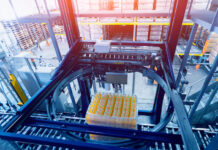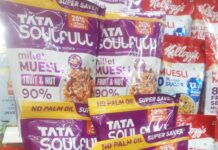Milk and dairy products are one of the most produced and valuable agricultural commodities across the world. Rigid packaging is not new to the dairy industry. In fact, it is evolving in many ways that will continually reduce their impact on the environment and create a positive impact in communities. Many innovations are taking place in the production of containers for dairy products. Efforts are on to make them lightweight, transparent to address consumer demands for product visibility and act as single-serving cups, tubs and bottles to appeal the health conscious and on-the-go lifestyle consumers.
To stand out in a crowded grocery store shelf, dairy processors are choosing rigid containers that catch the eye and connect with the consumers’ changing demands. The innovations in rigid containers are making it a lot easier for dairy processors to customize/personalize the look of the packaging without sacrificing the freshness or taste of the products. Rigid containers for dairy products today are designed to help enhance shelf impact, sustainability, convenience and premiumness.
Enhanced aesthetics
Most consumers pick up a product due to the eye-catching appeal of the packaging. This makes it important for dairy processors to think about aesthetic appeal while developing the best packaging for their product. Also, the distinctively shaped rigid packages command attention at a retail store. Among the wide range of similar products arranged on the store shelf, what stands out is a ‘smartly’ designed package. What truly makes a product stand out is its packaging design that has simple techniques like good color combination, catchy design and an attractive font type. Recently, the Dairy Farmers of America and advertising agency Barkley has designed a milk bottle with stylized black spots that are left along the glass to portray the same spots that are present on a milking cow.
Sustainability
Sustainability is another significant attribute for dairy product packaging. In the past few years, there has been a growing commitment worldwide within the industry to move away from single-use plastics and focus on recycled content, thinner material and non-plastic products. As a result, the packaging industry is showing considerable interest in transitioning to 100% recyclable or reusable packaging, as well as recycled-content materials. Evergreen Packaging, for instance, offers sustainable packaging solutions that help processors to keep up with the demand for sustainable containers. Evergreen’s fully renewable carton is made from renewable fiber from trees and renewable polyethylene from sugarcane.
Add-on features
Dairy packaging is becoming increasingly interactive with consumers. Today several methods are being used to detect spoilage of dairy products such as labels or materials that change color. The time-temperature indicators have been used for years to ensure proper handling of products and to retain their quality. New researches involve packages that would use interactions between cells to detect food that is starting to spoil. Sensors would detect cell-to-cell communications when they start to break down.
Innovative mix-in technologies
Recently, one of the most interesting developments in rigid containers is the advent of technologies that make it possible to separate ingredients until mixed together just prior to consumption. The package makes the consumer in charge of the mixing process. These mix-in technologies for liquid products offer a great potential for dairy products. The first patented KarmaCap is used by Karma Culture, Pittsford, New York for Karma wellness water. The bottle cap allows to dispense the probiotics with the push of a button as well as it protects dry probiotic cultures to maintain the highest efficacy without the need for refrigeration. Branson Ultrasonics, a subsidiary of Emerson, helped Karma Culture to overcome the challenge of welding the patented KarmaCap with its spin-welding technology.
The global market for dairy product packaging is witnessing healthy growth. As per a published report, by 2027, it is projected to expand at a CAGR of 4.5% and particularly in the Asia Pacific region, it is expected to grow even faster at a CAGR of 6.4%. The major driving force behind this growth includes urbanization, rising incomes, consumer awareness, increasing interest in clean labels and sustainability. As a result, the dairy product packaging industry is coming up with solutions like more portable packs, enhanced food safety, deliver clean labels and help companies achieve sustainability goals.
IndiFoodBev — authentic, impactful and influential
An English-language food and beverage processing and packaging industry B2B platform in print and web, IndiFoodBev is in its third year of publication. It is said that the Indian food and beverage industries represent approximately US$ 900 billion in revenues which implies more than 20% of the country’s GDP. Eliminating the wastage on the farmside can help to deliver more protein to a higher number of the population apart from generating sizable exports. The savings in soil, seeds, water, fertilizer, energy and ultimately food and nutrition could be the most immense contribution that country is poised to make to the moderation of climate change.
To improve your marketing and grow sales to the food and beverage processing and packaging industry, talk to us. Our research and consulting company IppStar [www.ippstar.org] can assess your potential and addressable markets in light of the competition. We can discuss marketing, communication, and sales strategies for market entry and growth.
Suppliers and service providers with a strategy and budget for targeted marketing can discuss using our hybrid print, web, video, and social media channels to create brand recognition linked to market relevance. Our technical writers are ready to meet you and your customers for content.
The second largest producer of fruit and vegetables in the world is continuously expanding processing capacities and delivery systems with appropriate innovative technologies. We cover product and consumer trends, nutrition, processing, research, equipment and packaging from farm to thali. Get our 2025 media kit and recalibrate your role in this dynamic market. Enhance your visibility and relevance to existing markets and turn potential customers into conversations. Ask for a sample copy of our bi-monthly in print or our weekly IndiFoodBev eZine each Wednesday.
For editorial info@ippgroup.in — for advertisement ads1@ippgroup.in and for subscriptions subscription@ippgroup.in
Naresh Khanna – 10 February 2025
Subscribe Now











